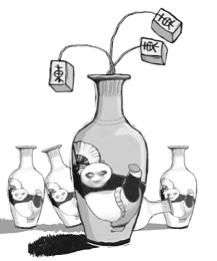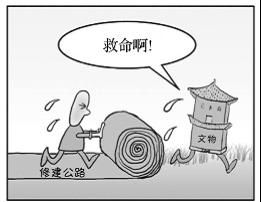網(wǎng)站介紹 關(guān)于我們 聯(lián)系方式 友情鏈接 廣告業(yè)務(wù) 幫助信息
1998-2022 ChinaKaoyan.com Network Studio. All Rights Reserved. 滬ICP備12018245號(hào)
弘揚(yáng)民族文化 思路點(diǎn)撥 圖片中共有三個(gè)內(nèi)容:陶瓷花瓶、功夫熊貓、麻將牌。這三種形象都是典型的中國(guó)元素。正如圖片的名稱“歐洲的‘中國(guó) 熱’”所說(shuō),一種學(xué)習(xí)中國(guó)傳統(tǒng)文化和漢語(yǔ)語(yǔ)言的熱潮正在歐洲悄然興起。毫無(wú)疑問(wèn),本圖的主題是:弘揚(yáng)中國(guó)文化,以及中國(guó)國(guó)際形象、國(guó)際地 位的上升。全文行思路可如下: 第一段:分別描述圖畫(huà)中體現(xiàn)出的中國(guó)元素;第二段:分析外國(guó)人對(duì)中華文化的興趣提升的原因+舉例;第三段:對(duì)待民族文化的正 確態(tài)度。 思維拓展 保護(hù)文物、文明遺產(chǎn)、名勝古跡的圖片也可以從捍衛(wèi)和弘揚(yáng)民族文化的角度入手加以分析論證。參考下圖: 高分范文 In the picture, we can see that there are some vases made of china, which are typical products in China since ancient time. An image of a panda playing Kung Fu① is carved on the surface of the vases, in which both Panda and Kung Fu are the symbols of Chinese elements. Besides, the Chinese mahjong which is growing out of a vase is also a typical Chinese element。 It is obvious that the main purpose of the picture is to reflect the phenomenon of “China fever”, referring to a foreign passion and enthusiasm② on Chinese elements, especially culture. There are reasons accounting for the growing interest in Chinese elements. For one thing, for the past decades, China has made conspicuous progress in all fields such as economy, science and technology, and comprehensive strength of China has been enhanced greatly. For another, due to the progress, China presents a new image to the world and is becoming increasingly attractive and appealing③ to the whole world. Nearly every day news stories are reported and broadcasted④ about what is going on in and around China. And By 2010, there are 72 Confucius Institutes in 26 European countries established to spread Chinese language and culture⑤。 Toward this kind of “China craze”, we should hold a right attitude. On the one hand, we should take pride in the “China craze” by foreigners, which originates from the increasing prestige of China. On the other hand, it is the responsibility of each Chinese citizen to popularize and promote excellent traditional Chinese culture and guard a favorable image of our motherland。 佳作妙譯 這幅圖中我們可以看到一些瓷制的花瓶,這是中國(guó)自古以來(lái)的典型產(chǎn)品。瓶身上畫(huà)著一只正在練習(xí)中國(guó)功夫的熊貓,熊貓和功夫同樣 是中國(guó)文化的代表。此外,花瓶中長(zhǎng)出的“麻將”也是典型的中國(guó)元素。 這幅漫畫(huà)的主要目的是反映“中國(guó)熱”的現(xiàn)象,即國(guó)外對(duì)中國(guó)元素尤其是中華文化的一種追捧和熱情。國(guó)外對(duì)中國(guó)元素興 趣上升的這種現(xiàn)象是有原因的。首先,過(guò)去的幾十年中,中國(guó)在經(jīng)濟(jì)、科技等各個(gè)領(lǐng)域都取得了顯著的進(jìn)步,中國(guó)的綜合國(guó)力已經(jīng)大幅提升。另一方面,由于 這些進(jìn)步,中國(guó)以嶄新的形象出現(xiàn)在世人面前,在全世界越來(lái)越有吸引力。幾乎每天都有很多關(guān)于中國(guó)及其周邊正在發(fā)生的新聞報(bào)道。截止到2010年,已經(jīng)有 26個(gè)歐洲國(guó)家建立了72所孔子學(xué)院來(lái)傳播中國(guó)語(yǔ)言和文化。 對(duì)于這種“中國(guó)熱”的現(xiàn)象我們應(yīng)該持有正確的態(tài)度。一方面我們應(yīng)該為外國(guó)人的“中國(guó)熱”感到自豪,這源 于中國(guó)聲望的提高。另一方面,弘揚(yáng)優(yōu)秀的中國(guó)傳統(tǒng)文化和捍衛(wèi)祖國(guó)的形象,是每一位中國(guó)公民的責(zé)任。 名師點(diǎn)評(píng) ① a panda playing Kung Fu: 正在練中國(guó)功夫的熊貓。其中playing Kung Fu 是后置定語(yǔ)修飾panda。 現(xiàn)在分詞作后置定語(yǔ)的寫法: 第一步:寫出定語(yǔ)從句:a panda that is playing Kung Fu; 第二步:把引導(dǎo)詞“that”和be動(dòng)詞“is”一起省略; ② passion and enthusiasm: 近義詞疊加,加強(qiáng)語(yǔ)氣和氣勢(shì)。 ③ attractive and appealing: 近義詞疊加,加強(qiáng)語(yǔ)氣和氣勢(shì)。 ④ reported and broadcasted: 近義詞疊加,加強(qiáng)語(yǔ)氣和氣勢(shì)。 ⑤ Confucius Institutes in 26 European countries established to spread Chinese language and culture: 其中 “established… culture”是Confucius Institutes(孔子學(xué)院)的后置定語(yǔ)。寫法:請(qǐng)參考《商業(yè)行賄》點(diǎn)評(píng)第①條。


來(lái)源未注明“中國(guó)考研網(wǎng)\考研信息網(wǎng)”的資訊、文章等均為轉(zhuǎn)載,本網(wǎng)站轉(zhuǎn)載出于傳遞更多信息之目的,并不意味著贊同其觀點(diǎn)或證實(shí)其內(nèi)容的真實(shí)性,如涉及版權(quán)問(wèn)題,請(qǐng)聯(lián)系本站管理員予以更改或刪除。如其他媒體、網(wǎng)站或個(gè)人從本網(wǎng)站下載使用,必須保留本網(wǎng)站注明的"稿件來(lái)源",并自負(fù)版權(quán)等法律責(zé)任。
來(lái)源注明“中國(guó)考研網(wǎng)”的文章,若需轉(zhuǎn)載請(qǐng)聯(lián)系管理員獲得相應(yīng)許可。
聯(lián)系方式:chinakaoyankefu@163.com

掃碼關(guān)注
了解考研最新消息
網(wǎng)站介紹 關(guān)于我們 聯(lián)系方式 友情鏈接 廣告業(yè)務(wù) 幫助信息
1998-2022 ChinaKaoyan.com Network Studio. All Rights Reserved. 滬ICP備12018245號(hào)

